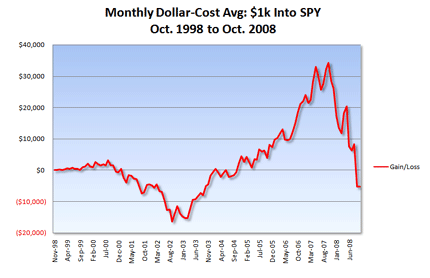
What's that show? Well, if you had made monthly investments of $1,000 into an S&P 500 exchange-traded fund (SPY, in this case) beginning in October of 1998, your 10 years of investment discipline would now be rewarded by ... oh, a loss of $5,188. This includes dividends being reinvested, but does not include any transaction fees. So, in the real world, actual losses would be worse. (All this assumes my spreadsheet math is correct, of course. I make no guarantees!)
As of early October 2008, your investment's cost basis would be $132,121. Its value in the marketplace, however, would be only $126,933. That's a loss of $5,188, or 3.93 percent.
Making this particularly painful would be the fact that as recently as October of 2007, your account showed an unrealized gain of over $34,400.
Ouch.
Never fear, though. Dave Ramsey assures us that "good growth-stock mutual funds" will return, on average, ten or twelve percent per year. (Never mind the fact that the majority of mutual funds actually lag the performance of the S&P 500 over any given period of time.)
Stuff like this is precisely why financial gurus' relentless devotion to mutual-funds as sources of "double-digit annual returns" drives me nuts.
Labels: Investing


